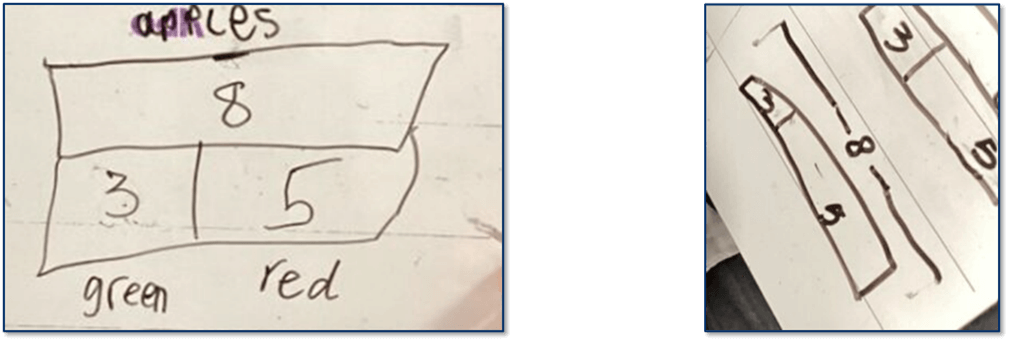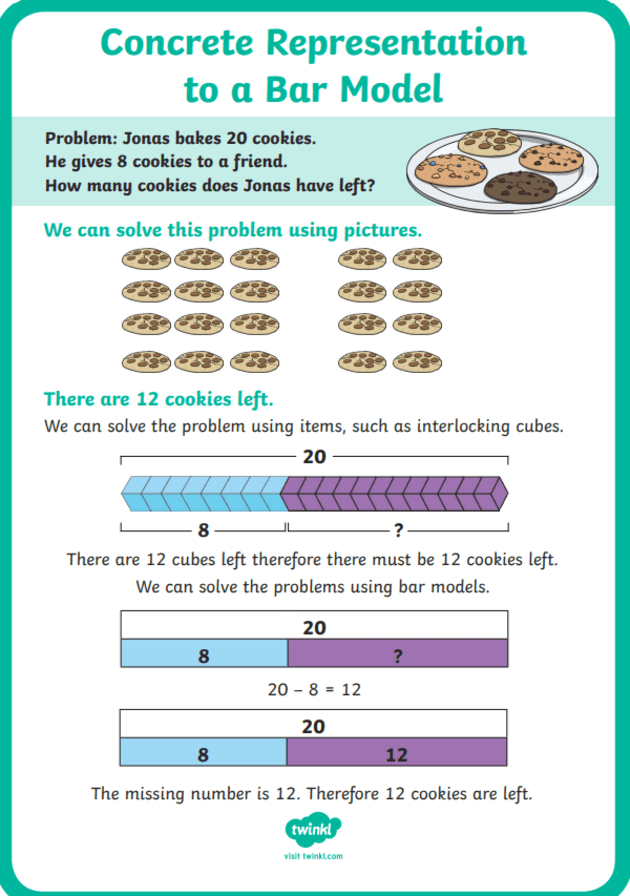Exploring Bar Model Illustration Techniques: A Comprehensive Overview to Imagining Math Concepts
Bar version drawing techniques offer as a beneficial source for both teachers and trainees in envisioning mathematical ideas. These versions simplify complicated numerical connections, assisting in the understanding of addition, division, reduction, and multiplication. This guide details reliable techniques for applying bar designs, cultivating active involvement and real-world links. As viewers explore the useful applications and mentor tips, they will uncover how these techniques can change their strategy to mathematics.
Recognizing the Basics of Bar Version Drawing
Bar version drawing acts as an effective aesthetic tool in mathematics, facilitating the understanding of mathematical connections and problem-solving strategies. This technique entails standing for numbers and their connections with rectangular bars, making it easier to imagine operations such as enhancement, department, reduction, and reproduction. Each bar's size matches to a particular value, allowing learners to contrast amounts and recognize percentages clearly.
To create a bar version, one begins by identifying the problem's essential components, often simplifying right into components that can be visually represented. In a simple addition problem, two bars can be drawn, with their sizes standing for the addends. The combined length illustrates the sum. On top of that, bar models can be adapted for much more complicated issues, including ratios and fractions, by adjusting benches as necessary. Understanding these essentials lays a solid structure for reliable analytic and much deeper mathematical comprehension.
Benefits of Making Use Of Bar Models in Math
Utilizing bar designs in maths offers many benefits that enhance discovering and comprehension. These graphes help trainees in understanding complex principles by damaging them down into manageable parts. Bar designs supply a clear framework for highlighting connections between numbers, making abstract concepts much more concrete. They advertise a deeper understanding of mathematical procedures and assist in problem-solving by permitting students to visualize the information they are dealing with.
Furthermore, bar versions support the growth of critical assuming skills, as pupils need to analyze and analyze the visual info to draw final thoughts. This method motivates active engagement with the material, reinforcing retention and proficiency of mathematical concepts. By fostering a solid structure in aesthetic literacy, bar designs encourage learners to approach different mathematical obstacles with self-confidence. Generally, the assimilation of bar models right into maths education shows valuable in cultivating both understanding and logical capacities among trainees.
Using Bar Versions to Enhancement and Subtraction
Bar designs offer as a reliable device for aesthetically standing for enhancement and reduction troubles. By illustrating the relationship between numbers, they boost understanding and help with analytical. In enhancement, real-life applications of these models can aid learners understand mathematical ideas in functional contexts.
Standing For Addition Visually
Visual aids can greatly improve their understanding of these operations when students experience addition and reduction problems. Bar designs work as reliable tools for representing enhancement. By separating a rectangle into segments that match to the numbers included, students can envision the partnership between the quantities. As an example, if a student needs to include 3 and 5, they can create a bar split right into 2 areas: one area representing 3 and the various other representing 5. This clear representation not just simplifies the enhancement procedure yet also enhances the concept of integrating amounts. As pupils manipulate these visual aids, they create a much deeper comprehension of addition, bring about improved analytical abilities and higher confidence in their mathematical capabilities.
Reduction With Bar Versions
Although reduction is typically regarded as an extra complex operation than addition, bar models can successfully clarify this procedure for trainees. By visually standing for the amounts entailed, students can better understand how numbers connect to one another. In a bar design for reduction, one bar stands for the total amount, while another shows the amount being subtracted. This aesthetic difference assists trainees understand the concept of "taking away." As an example, if a bar reveals 10 devices, and one more bar representing 4 units is removed, pupils can conveniently see that 6 systems stay. This strategy not only fosters understanding of subtraction but likewise help in creating analytic abilities, enabling students to visualize their mathematical thinking and improve their overall understanding of mathematical ideas.
Real-Life Application Instances
Recognizing subtraction via bar designs lays a foundation for using these techniques in real-life circumstances. In various contexts, such as budgeting or purchasing, individuals can visualize just how much money continues to be after expenditures. For instance, if an individual has $50 and spends $20, a bar version can represent the complete amount and the invested section, highlighting that $30 is left. In addition, moms and dads can utilize bar models to aid kids recognize the number of even more products require to be contributed to finish a set, such as having 3 apples and needing five. This aesthetic representation simplifies intricate problems, promoting comprehension and retention. Ultimately, bar designs function as reliable tools in everyday decision-making, improving mathematical understanding in sensible scenarios.
Picturing Reproduction and Department With Bar Versions
In exploring the application of bar models for multiplication and division, it is vital to grasp their foundational ideas. Creating reproduction designs permits learners to imagine relationships in between numbers, while effective division strategies can be illustrated through these visual help. This strategy boosts understanding and analytic skills in mathematics.
Understanding Bar Models
Bar models serve as an effective aesthetic tool for showing the ideas of multiplication and division. They allow students to represent mathematical relationships in an organized format, helping with a deeper understanding of these procedures. In multiplication, bar models display teams of equal size, permitting people to imagine the total quantity when integrating these groups. On the other hand, in division, bar models help depict how a total is split right into smaller sized, equivalent components, clarifying the idea of partitioning. By employing these aesthetic help, pupils can comprehend the underlying concepts more info of reproduction and department extra successfully. This method not just boosts comprehension yet likewise sustains problem-solving abilities, making bar models an important property in mathematical education.
Creating Multiplication Designs
Constructing multiplication versions utilizing bar diagrams supplies a clear method for visualizing the procedure of reproduction. These designs enable learners to stand for reproduction as groups of equal components, making abstract principles more concrete. For circumstances, to highlight (3 times 4), a student can draw one bar divided into three equal sections, each representing 4 devices. Additionally, creating a second bar with the exact same size enhances the understanding of repeated enhancement, as each segment matches to one group. This visual representation not only help in grasping multiplication however additionally enhances analytic abilities. By employing bar designs, students can much better comprehend partnerships in between numbers and create a durable structure for extra complex mathematical ideas, bring about increased self-confidence in their capacities.
Envisioning Department Approaches

Resolving Word Troubles Utilizing Bar Design Techniques

As an example, in a trouble involving enhancement and reduction, trainees can attract different bars for every amount and after that control them to find the remedy. This procedure not only clarifies the trouble however additionally cultivates a deeper conceptual understanding. Furthermore, bar models can be adapted for various kinds of word problems, making them functional throughout different mathematical subjects. Eventually, making use of bar models can considerably improve trainees' analytic skills by supplying a clear visual pathway to get to the appropriate response.
Integrating Bar Versions in Different Mathematics Topics
Bar models can be effortlessly integrated into numerous math topics, enhancing trainees' understanding of principles beyond basic arithmetic. In algebra, these aesthetic devices aid in standing for formulas and inequalities, allowing students to envision relationships between variables. When dealing with geometry, bar designs can highlight the homes of forms and spatial reasoning, assisting pupils grasp ideas like area and perimeter successfully. In statistics, bar designs facilitate the interpretation of information sets, permitting pupils to compare quantities and identify trends aesthetically. Furthermore, incorporating bar versions within dimension subjects help in comprehending systems and conversions by supplying a concrete representation of quantities. By utilizing bar designs across different mathematical locations, instructors can cultivate a much deeper comprehension of complex concepts, thereby boosting analytic abilities and advertising critical thinking (bar model drawing techniques). This convenience demonstrates the energy of bar designs as a foundational device for trainees in their mathematical journey
Tips for Teaching Bar Versions Successfully
Integrating bar versions right into teaching techniques needs thoughtful techniques to maximize their performance. Educators must begin by introducing bar versions with basic, relatable examples that students can conveniently comprehend. This helps to build confidence and knowledge with the idea. Gradually raising the complexity of problems enables learners to use their skills considerably. Additionally, educators must encourage trainees to produce their own bar versions, advertising active interaction and possession of their knowing.
Incorporating collaborative activities can also improve understanding, as students discuss and resolve problems in groups. Continuous comments is necessary; teachers ought to give constructive discourse on pupils' bar model depictions to assist enhancement. Attaching bar designs to real-life scenarios strengthens their relevance, assisting pupils see the functional applications of their mathematical abilities. By executing these approaches, educators can effectively harness the power of bar versions in their mathematics direction.
Often Asked Concerns
Can Bar Models Be Made Use Of in Other Topics Besides Math?
Bar designs can without a doubt be utilized in different subjects past math. They efficiently illustrate principles in scientific research, social researches, and language arts, aiding to visually stand for relationships, processes, and concepts for boosted understanding across self-controls.
What Age Is Ideal Fit for Knowing Bar Designs?
Bar versions are best fit for children ages 7 to 12, as they establish concrete reasoning skills during this period (bar model drawing techniques). At this age, pupils can properly understand abstract concepts through graph and analytical strategies
Are There Digital Devices for Creating Bar Designs?

Exactly How Can I Assess Pupil Understanding of Bar Designs?
Assessing student understanding of bar models can involve quizzes, empirical assessments, and seminar. Teachers may additionally evaluate students' completed models and their capability to explain their thinking, making sure a detailed analysis of understanding.
What Prevail Blunders When Utilizing Bar Models?
Typical errors when making use of bar designs include misstating quantities, stopping working to precisely classify bars, puzzling addition and reduction, ignoring to use consistent scales, and ignoring the significance of clear aesthetic separation in between various aspects.
In enhancement, bar versions can be adapted for more complex troubles, including ratios and fractions, by changing the bars as necessary. Subtraction is commonly viewed as a more complicated operation than enhancement, bar versions can efficiently clarify this procedure for trainees. In a bar design for subtraction, one bar represents the total amount, while one more shows the amount being deducted. If a bar shows 10 systems, and one more bar standing for 4 systems is gotten rid of, students can conveniently see that 6 systems continue to be. When splitting a total amount into equal teams, trainees can attract a long bar to represent the whole and after that segment it into smaller bars that suggest each team.